Paris may be the City of Light, but after dark, its streets can tell different stories: ghost stories. Behind the elegance of its boulevards and the glow of its monuments, the French capital hides centuries of mystery, tragedy and restless spirits. From haunted theatres to cursed palaces, ghostly figures wander through the city’s history, fuelling our imagination. Let’s follow the traces of the ghosts of Paris, and see if they are still haunting the city…
The Phantom of the Opera
The first official appearance of the Phantom dates back to 1909, when French writer Gaston Leroux featured Erik in his serial “The Phantom of the Opera.” The so-called ghost is said to haunt the halls of the Palais Garnier, especially box no. 5, roaming the corridors and causing disasters and mayhem in the theatre. Leroux’s novel reveals that he is none other than a man consumed by unrequited love, ready to abduct the woman he desires regardless of her own wishes (talk about a toxic relationship). Her lover, a detective, eventually saves her.
In fact, Leroux may have drawn inspiration from various accidents that had occurred in theatres and opera houses at the time, particularly fires caused by candles used to light the stage. One infamous incident, which caused the death of ballerina Emma Livry in 1862 on the stage of the Opéra-Comique, could have inspired the author. Legend has it that her disfigured fiancé survived… he may have been one of the first avatars of the Phantom of the Opera. Commissioned by Napoleon III, the Palais Garnier itself was constructed after a fire that destroyed the Le Peletier opera house in 1873.
Another element adding to the strangeness of the Palais Garnier and perpetuating the myth of a ghost living within its walls is the fact that beneath the building lies one of the largest underground water reservoirs in Paris (inaccessible to the public). Originally, the edifice was built on marshland, and this reservoir was a technical solution to prevent the theatre from sinking. Today, Paris firefighters occasionally train in the water tank.
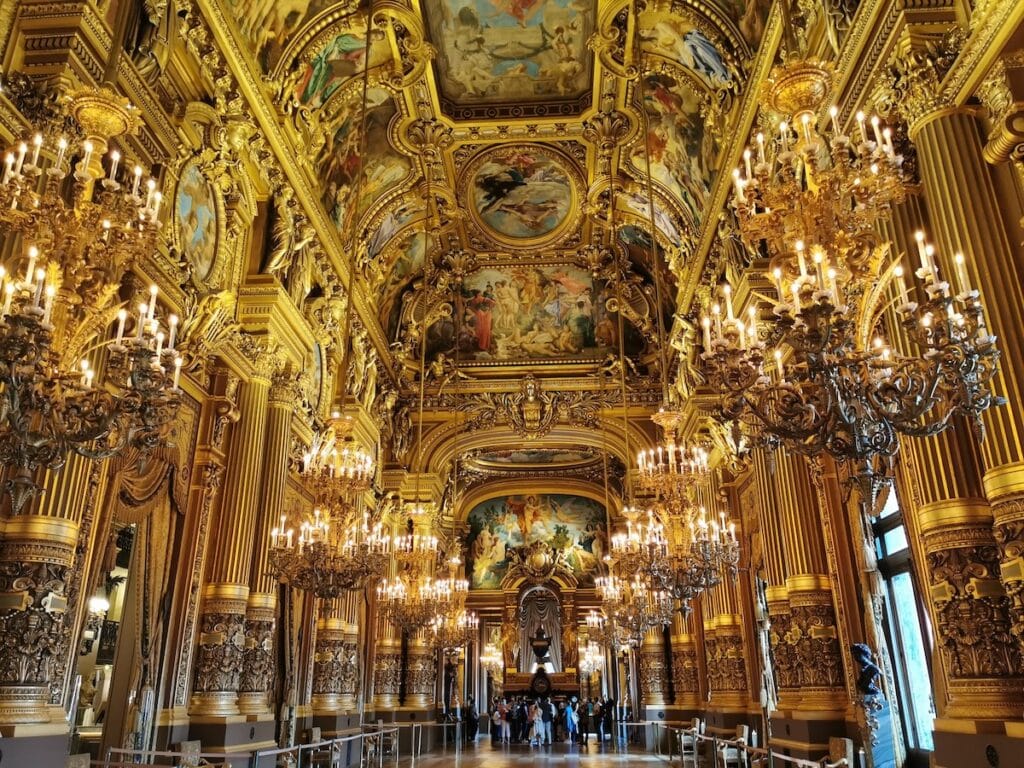
How to visit Palais Garnier (Opéra de Paris)
The magnificent Palais Garnier can be visited by reservation, with or without a guided tour. Guides usually point out the famous box no. 5, permanently reserved for the Phantom. Yet the rest of the opera house never fails to impress: from the grand staircase to the spectacular Grand Foyer gallery and the modern cupola painted by Chagall. Don’t miss this visit during your Paris holiday, whatever the season.
- Place de l’Opéra – Paris 9
- Visit the Palais Garnier
- @operadeparis
- Entrance for visitors is located behind the building, where rue Scribe meets rue Auber
The Red Man of the Tuileries
It is probably one of the oldest ghost stories in Paris, still known today. The apparition of the Flayer of the Tuileries, also called the Red Man of the Tuileries, dates back to the reign of Catherine de Medici in the 16th century. Legend has it that Jean l’Écorcheur, a butcher working in the royal slaughterhouse and one of the Queen’s henchmen, knew too much and had to be silenced. Catherine de Medici’s right-hand man was tasked with the deed. He and his men succeeded in ending Jean’s life, but before dying, he cursed them all, shouting: “I will be back!”
Dates are uncertain, but most sources state that when Catherine de Medici began building the Palace of the Tuileries (now gone), her counsellor reported that he saw a ghostly “man covered in blood” who had predicted her doom “near Saint-Germain”. She took the warning seriously and avoided the area of Saint-Germain all her life. However, at her deathbed in 1589, her confessor was named… Laurent de Saint-Germain. Ever since, the Red Man of the Tuileries is said to appear before French sovereigns, foretelling their downfall.
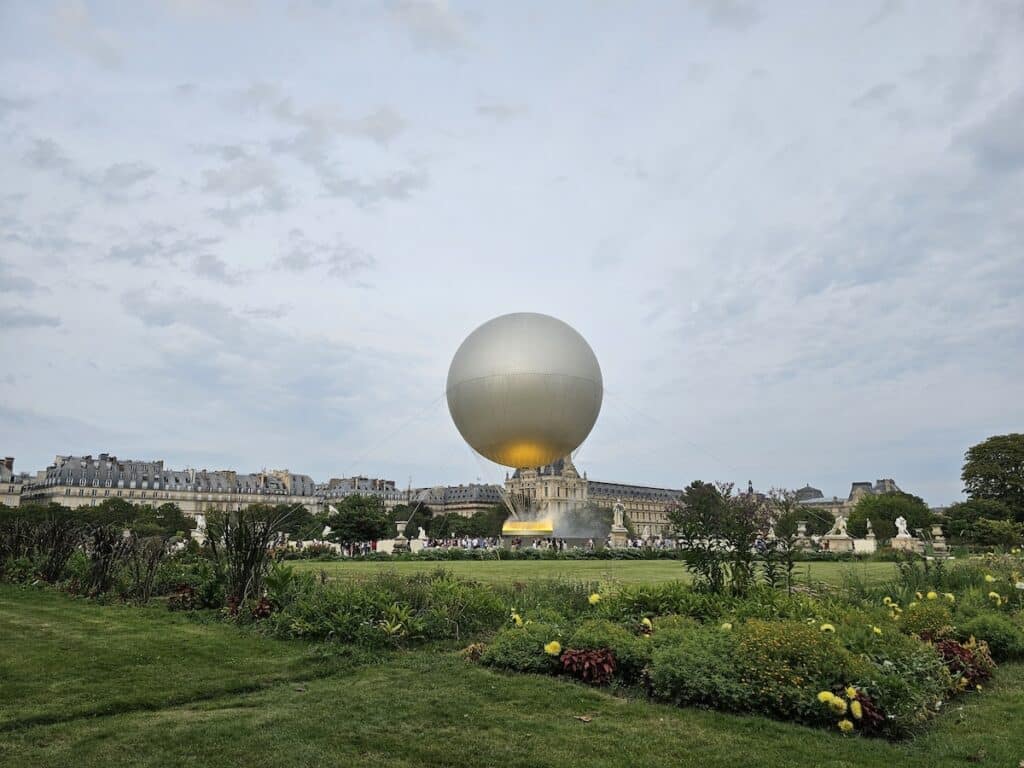
What to see in the Tuileries gardens today
Nothing remains of Catherine de Medici’s Palais des Tuileries. In its place now stands one of Paris’s most iconic parks, the oldest and largest one, extending from the Louvre to the Place de la Concorde, and serving as an open-air sculpture museum. It features a beautiful jardin à la française and is beloved by locals who come here to jog, picnic, or simply sunbathe with a book on bright days. The garden is also home to two fascinating museums: the Musée de l’Orangerie, which houses Monet’s famous Water Lilies, and the Jeu de Paume gallery, a temple of visual arts and digital media. I hope you won’t see any Red Man around there… it’s not a good omen!
The Man in the Frock Coat
This is by far one of my favourite ghost stories ever…. In 1925, Jean Romier, a young medical student, met an elegant older man in the Luxembourg Gardens. The man, wearing a dark frock coat, introduced himself as Alphonse Berruyer. Jean and Alphonse soon discovered a shared passion for classical music, and the man in the frock coat invited Jean to a private concert at his home. The young student gladly accepted and spent a delightful evening there. But when he returned home that night, he realised he had forgotten his watch.
The next day, he went back to the flat, only to find the door tightly closed and a housekeeper annoyed at his insistance! “This flat has been empty for years!” she claims, finally contacting the current owner. At Jean’s description of the man, the owner was astonished: he recognised the former owner, but said Alphonse Berruyer had died over 20 years ago! Nevertheless, he agreed to let Jean see the flat. When they opened the door, they found an empty, almost abandoned room, with no furniture at all. But on closer inspection, an old watch, covered in thick dust, lay on the mantelpiece…
How to visit Jardin du Luxembourg
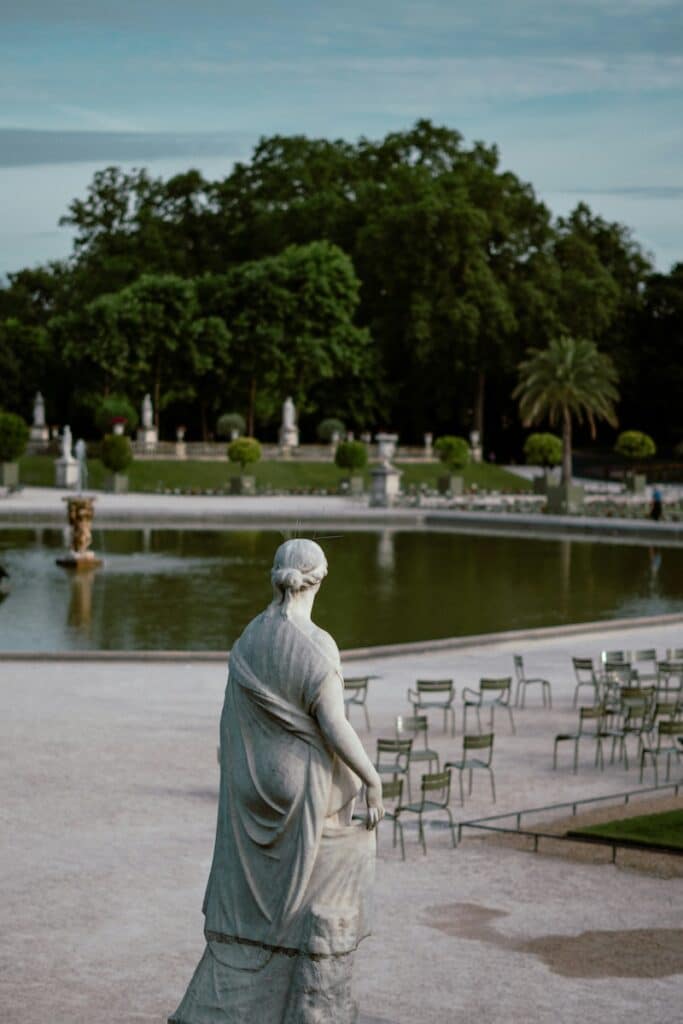
The Jardin du Luxembourg is truly one of the most beautiful gardens in Paris, with so much to offer. It is home to the Senate, but also regularly hosts exhibitions in its various cultural spaces: at the Musée du Luxembourg, sometimes in the Orangerie building, and even along the park’s railings, where high-quality photographic displays are often presented.
It’s also loved by locals who make the most of its many areas. One of Parisian children’s favourite activities is to sail toy boats on the central fountain. The Fontaine de Médicis and the many statues of French queens have long been among my favourite sights in Paris too. A section of the park is dog-friendly, which I particularly appreciate nowadays, since I have Kitsu.
All in all, you could easily spend an entire afternoon here, especially in summer, when it’s one of Parisians’ favourite spots for picnics.
Belphegor, the Ghost of the Louvre
The ghost of the Louvre first appeared in a novel in 1927, but he was really immortalised in a 1960s television series, where an ancient demonic spirit, trapped within an Egyptian mummy, comes to life after dark, roaming the museum’s silent corridors. The figure, cloaked entirely in black, drifts through the galleries like a shadow, haunting the department of Egyptian Antiquities. In the 2001 film version, the ghost turns out to be a human in flesh, manipulated by a secret society with occult purposes.
Actually, the legend goes a while further back and borrows the name of an ancient demon, possibly one of the Seven Princes of Hell. In the Old Testament, Belphegor was not a ghost, but a demon said to have been worshipped by the Hebrews who were seduced by Moabite women. The Moabites were a pagan nation living east of the Dead Sea, who did not believe in the One God. So over time, Belphegor came to symbolise lust, deceit, and debauchery (as opposed to the order of the monothéeist religion).
Perhaps that’s why he inspired this spectral presence at the Louvre, being a spirit born from desire, still wandering among relics of the ancient world, when night falls over the museum…
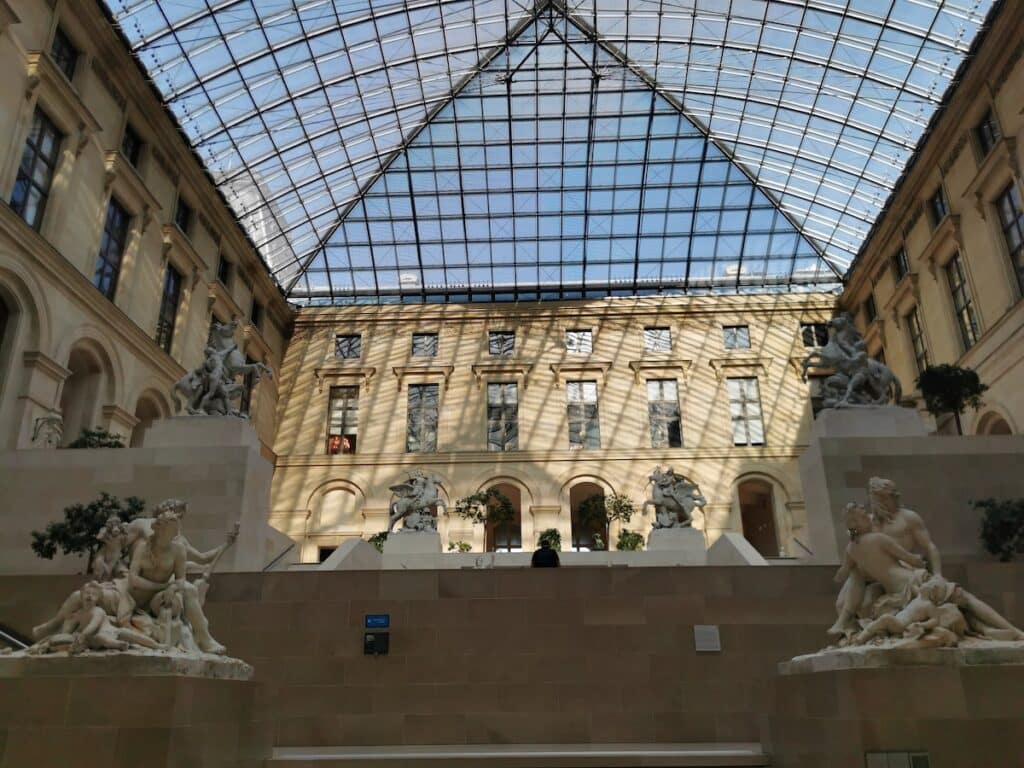
How to plan your visit to the Louvre Museum
Hopefully, Belphegor hasn’t scared you off and you don’t want to miss the museum of Paris. The Louvre is of course a must-see during your stay in Paris. You can easily spend half a day or a full day for the most passionate, exploring its galleries (so it’s worth booking your ticket in advance to avoid long queues).
The museum is open until 9pm on Wednesdays and Fridays, when it offers its famous “nocturne”: a quieter, more atmospheric experience that lets you wander beneath the glass pyramid and through the dimly lit halls after dark. Whether you come for the masterpieces or the mysteries, seeing the Louvre by night is an experience you won’t forget.
- Louvre official ticketing service
- Check the list of available galleries at the time of your visit.
- The Louvre is open everyday except Tuesday, from 9am to 6pm, and to 9pm on Wed. and Fri.
Jim Morrison’s Ghost
This ghost story isn’t even a real one (if you can call the others “real”, haha). It has long been partly debunked, but it certainly drew even more attention to one of the most famous grave in Père Lachaise Cemetery. Of course, we’re talking about the grave of the singer of The Doors. No need to introduce Jim Morrison, nor the mini-temple his grave has become. Vandalised several times and now usually protected by barriers, it’s no longer possible to get very close.
Anyway, music journalist Brett Meisner visited Morrison’s grave in Paris in 1997, taking a series of photos in front of it. A few years later, one of these pictures resurfaced: behind the journalist appeared a vague, ghostly figure with outstretched arms. That was all it took: Meisner claimed he was haunted by the ghost of Jim Morrison. The story spread widely, until a few months later, the journalist took part in a TV show where he stayed in the supposedly haunted hotel room of the singer. So, was the whole ghost story in Paris just a teaser for his television appearance? Maybe.
How to visit Père Lachaise Cemetery
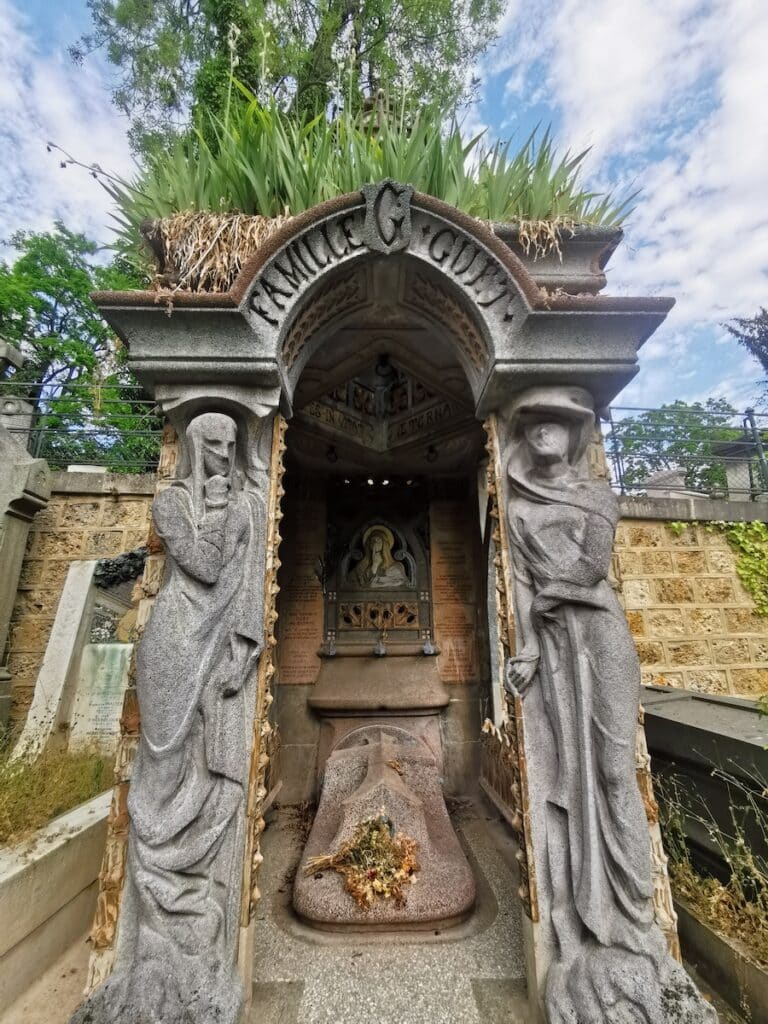
I’m not a fan of The Doors, but one must admit the cult surrounding Jim Morrison’s grave is impressive. Thousands of chewing gums (disgusting!) are still stuck and dried over the stones. But if you visit Père Lachaise Cemetery, I urge you to take a full tour and not stop only at the celebrities’ graves. There are over 70,000 tombs here — some spectacular, others simple, and a few with a truly mystical aura.
In any case, I strongly recommend approaching the world’s most famous cemetery as a garden, since that’s how it was originally designed: an eternal garden of rest. It remains one of my favourite places in Paris.
- Père Lachaise cemetery is open from 8am of weekdays, 9am on weekends. Seasonal opening hours apply to check on the website to plan your visit.
- Don’t forget to use a map to find your way through the graves
- Or don’t, but remember the only exit at closing time is the northern one (on Av. Gambetta)
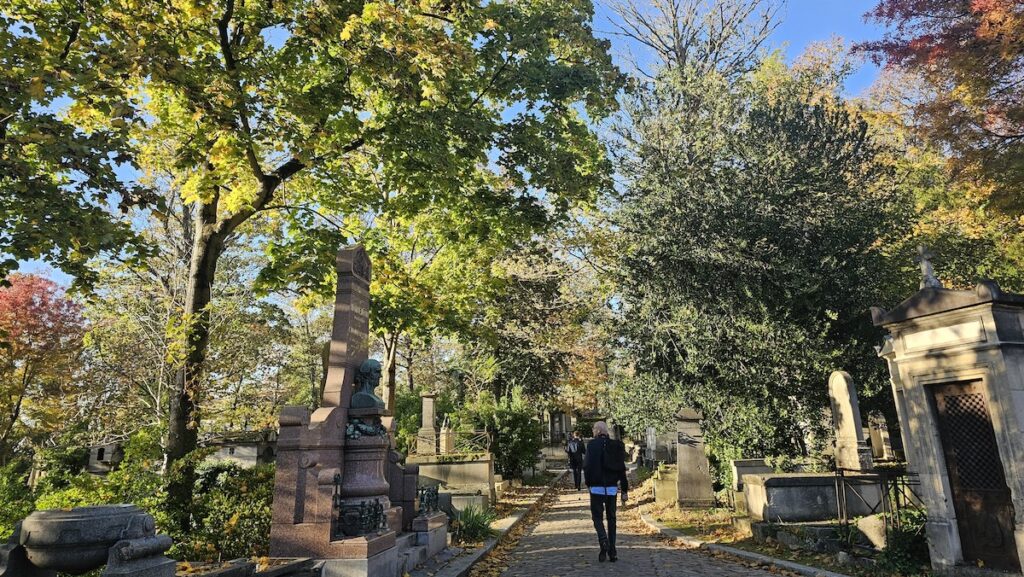



No Comments